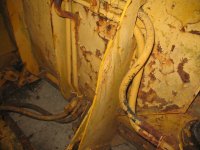</font><font color="blue" class="small">( Jinman's name comes to mind here. )</font>
Who ya' gonna call?...
HOSE BUSTERS! /forums/images/graemlins/laugh.gif /forums/images/graemlins/laugh.gif /forums/images/graemlins/laugh.gif
Yes, I have replaced every one of my four short hoses going to the curl cylinders. None of the hoses I've replaced have busted the second time. The new ones are all 4000 psi, 2-wire hoses. The originals are 1-wire and about 3000 psi hoses. All of the original hoses failed at the swage fitting. Two of them spewed an atomized mist only under high pressure. Even though I replaced the hoses, I still keep one spare. The cost of getting a spare hose made the next time someone is at the dealer is nothing compared to the cost of delay on a jobsite. When a hose blows, your loader is just useless dead weight hanging off the front of your tractor. You can't use it; end of story. /forums/images/graemlins/tongue.gif /forums/images/graemlins/frown.gif
In my opinion, a person using a loader for constant landscaping chores is much more likely to experience hose failure than a person who uses forks to lift materials, a bucket to load or spread loose materials, or even a person who digs in the ground with the loader. In landscaping, the chance of hitting an unseen and immovable object or a sudden jolt to the bucket is much greater. Bumping a concrete walk or driveway is about all it takes to make a huge pressure spike in the loader's hydraulic system. Remember, the only time the hydraulics are protected by a pressure relief valve is when the joystick is not centered (lifting or changing position). If you are pushing a load with the joystick centered and hit an obstruction like a rock, stump, or concrete walkway, you may cause a spike as high as 7,000 psi. If you could put a pressure gage T'd into the loader hydralic line, I think you'd be surprised to see just how high these unprotected spikes can be. When they are high enough, the hose will let go. /forums/images/graemlins/shocked.gif
Don't be fooled by the cosmetic appearance of the outside rubber on a hose. Remember, just because an auto tire has lots of tread, it doesn't make it able to take more air pressure. What holds that pressure is the cord inside the rubber of a tire. Similarly, the woven wire layers inside the hose, beneath the rubber layer, are the strength of the hydraulic hose. The rubber protects the woven wire from chafing and being exposed directly to the weather. It also protects anything the hose may rub against like the tractor or even us. Sometimes the woven wire may have a few barbs that can poke or punch hands/fingers. Not all woven wire is stainless, so exposing it may also lead to it becoming rusted and weakened.
If you have a quality hose, there is no reason it may not last for years and years, but I am not convinced that the OEM hoses on our loaders are top-of-the-line. That just hasn't been my personal experience. /forums/images/graemlins/smirk.gif
So take the advice of "The hose buster" and keep yourself working by having at least one spare short 18" hose for the curl cylinder. It will be an insurance policy that costs less than $20. /forums/images/graemlins/cool.gif

